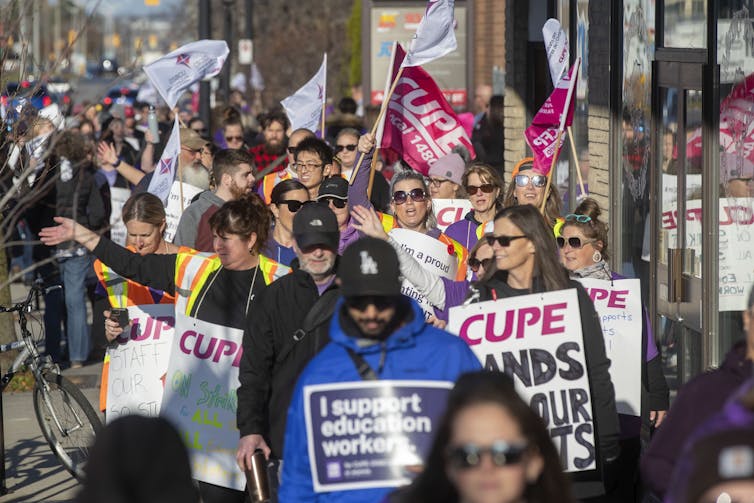Imagine receiving a letter informing you that your job is relocating to another province. Your employment is contingent upon you moving and your employer refuses to discuss it with you.
Or imagine developing an innovative plan for more flexible at-home work options that will reduce your company’s carbon emissions and save your employer money. Your manager, instead of praising your efforts, admonishes you and tells you to focus on your core work — not to “rock the boat.”
Workers around the world face dilemmas like these on a regular basis. At their core, they touch on the notion of worker voice: workers’ capacities and opportunities to speak up and effect change at work.
In light of the impacts of the COVID-19 pandemic, recent labour disputes, concerns about worker shortages and racism and inequality, a growing chorus of people are asking: how can all workers have the opportunity to meaningfully influence workplace decisions and have their voices heard?
Worker voice
Worker voice doesn’t just empower workers. It also has wide-ranging benefits for employers and broader society as well. It can help protect workers’ interests, improve workplace performance and contribute to societal democratization.
Unfortunately, unless Canadian workers are covered by a collective agreement, opportunities to shape decisions at work are largely at the whim of their employer. This leads to situations in which some workers have ample opportunities to speak up at work, while others — often those more marginalized — have almost none.

Even our most robust channels, like collective bargaining and grievance procedures, have been criticized by some as being too adversarial or not protective enough of individual rights and interests of their diverse membership.
Clearly, our practices and systems need an upgrade. The question is: what kind of upgrade would best serve workers and our economy as a whole?
Building a democratic assembly
To tackle this issue, we gathered a group of 32 Ontarians to serve in the Ontario Assembly on Workplace Democracy (OAWD). This was a first-of-its-kind effort that used a democratic innovation known as a “citizens’ assembly.”

The process involved selecting individuals through a democratic lottery, which generated a group of participants representative of the diversity of the province in their union status, sector, gender, income level and age. They were far from the usual suspects typically involved in policy discussions about this topic.
Over five intensive working sessions spanning the summer and fall of 2022, OAWD members re-imagined how workers shape organizational decision-making in Ontario.
They had frank conversations with each other about their experiences speaking up at work, developed principles that should underpin any robust system of worker voice, and brainstormed recommendations for employers, unions and governments to improve worker voice. These discussions were aided by a dedicated team of facilitators and a diverse group of expert and stakeholder witnesses.
Barriers to worker voice
A final report compiling the participants’ main conclusions has just been published through the University of Toronto’s Centre for Industrial Relations and Human Resources, which sponsored the project.
Insights from the final report have much to offer to workers, managers, labour advocates and policymakers. First, they pointed to numerous challenges and barriers people face when speaking up at work that need to be addressed.
Some of these barriers included fearing retaliation and negative repercussions from employers and a lack of structured opportunities for having their voices heard at work. Participants also highlighted that many people lacked basic information and knowledge about worker voice, government protections under the Charter of Rights and Freedoms and their right to unionize.
Participants also highlighted how traditionally marginalized groups of workers, like migrant workers or those with disabilities, face systematic barriers to voice, especially when they brought up concerns about discrimination at work.
Report recommendations
After identifying these barriers, assembly participants produced a set of 14 comprehensive recommendations for improving worker voice. These recommendations were grounded in a common set of values, including the financial success and sustainability of the participants’ employers, a greater balance of power between workers and their employers, and accountability.

Managers, labour advocates and policymakers interested in worker voice can get started on five of these recommendations right now. Firstly, all of these groups can — and should — do a better job of educating workers about their rights and responsibilities when it comes to voicing ideas and concerns at work.
Secondly, employers can implement best practices to encourage worker voice at work, through things like worker councils and self-managed teams. Thirdly, employers should also ensure workers are both incentivized and protected to use these tools and resources. Fourthly, employers should measure their progress toward improving worker voice, and benchmark it against their competitors.
And lastly, labour unions can open themselves up to more involvement from their diverse membership and provide greater transparency about their finances and decision-making processes.
Worker perspectives are critical
While worker voice is important, it often flies under our collective radar. To date, much of the void has been filled by academics, think tanks and organizations like chambers of commerce and labour unions. But the perspective of everyday people is just as important.
The OAWD put a spotlight on how everyday people experience work and what they want done to make work better and their voices heard. Participants embraced their responsibility and worked hard to deliver on the assembly’s mandate.
To improve the ability of workers to have a say in workplace decision-making, these recommendations should be read and considered widely by policymakers, politicians, the media and the broader public. It is up to these leaders to listen to workers and take the necessary steps to create fairer, safer, more inclusive and sustainable workplaces.

